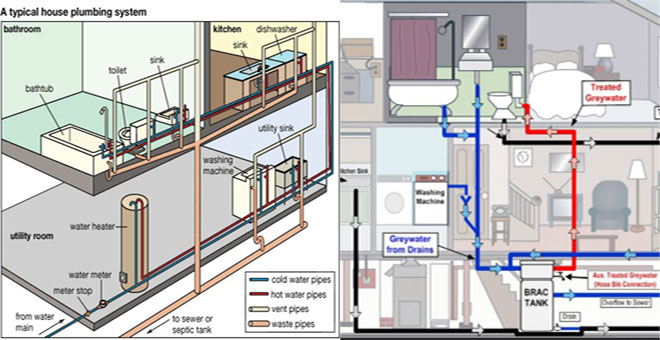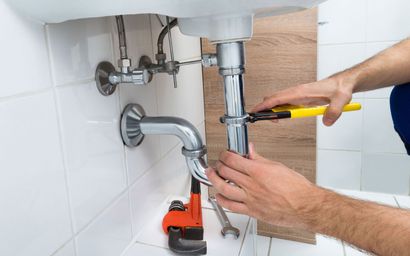Essential Insights About Your Home's Plumbing System Anatomy
Essential Insights About Your Home's Plumbing System Anatomy
Blog Article
We've come across this article about Plumbing Installation 101: All You Need to Know listed below on the web and accepted it made good sense to share it with you in this article.

Recognizing exactly how your home's pipes system functions is essential for every homeowner. From delivering clean water for drinking, cooking, and showering to securely eliminating wastewater, a well-maintained plumbing system is essential for your family's wellness and comfort. In this thorough overview, we'll discover the elaborate network that makes up your home's plumbing and offer ideas on upkeep, upgrades, and managing usual concerns.
Intro
Your home's plumbing system is more than just a network of pipelines; it's a complex system that ensures you have access to tidy water and effective wastewater elimination. Knowing its elements and how they work together can assist you prevent expensive fixings and make sure everything runs smoothly.
Fundamental Components of a Plumbing System
Pipelines and Tubing
At the heart of your plumbing system are the pipes and tubing that bring water throughout your home. These can be made from numerous products such as copper, PVC, or PEX, each with its advantages in terms of longevity and cost-effectiveness.
Fixtures: Sinks, Toilets, Showers, etc.
Components like sinks, commodes, showers, and bath tubs are where water is utilized in your house. Comprehending how these fixtures link to the pipes system aids in detecting issues and planning upgrades.
Shutoffs and Shut-off Points
Valves control the circulation of water in your plumbing system. Shut-off shutoffs are important during emergency situations or when you need to make repair work, allowing you to separate parts of the system without interrupting water circulation to the entire residence.
Water System System
Main Water Line
The main water line connects your home to the municipal supply of water or an exclusive well. It's where water enters your home and is dispersed to numerous components.
Water Meter and Pressure Regulator
The water meter steps your water usage, while a stress regulatory authority makes sure that water moves at a risk-free stress throughout your home's plumbing system, stopping damages to pipelines and components.
Cold Water vs. Hot Water Lines
Recognizing the difference between cold water lines, which supply water straight from the primary, and warm water lines, which bring warmed water from the hot water heater, helps in repairing and preparing for upgrades.
Drainage System
Drain Pipes Pipeline and Traps
Drain pipelines carry wastewater far from sinks, showers, and bathrooms to the sewage system or septic system. Catches avoid drain gases from entering your home and also catch debris that might cause blockages.
Air flow Pipes
Air flow pipes allow air right into the drain system, avoiding suction that might reduce drain and cause traps to empty. Correct ventilation is essential for preserving the integrity of your plumbing system.
Value of Correct Water Drainage
Guaranteeing appropriate water drainage avoids back-ups and water damage. On a regular basis cleaning drains and preserving catches can prevent expensive fixings and extend the life of your pipes system.
Water Heater
Types of Water Heaters
Water heaters can be tankless or standard tank-style. Tankless heating systems warmth water as needed, while tanks keep heated water for prompt usage.
Exactly How Water Heaters Attach to the Plumbing System
Comprehending just how hot water heater attach to both the cold water supply and warm water circulation lines aids in diagnosing concerns like insufficient hot water or leakages.
Maintenance Tips for Water Heaters
On a regular basis flushing your hot water heater to eliminate sediment, checking the temperature settings, and checking for leaks can expand its life-span and boost energy performance.
Common Plumbing Issues
Leaks and Their Reasons
Leaks can occur because of maturing pipes, loosened fittings, or high water stress. Addressing leakages without delay protects against water damage and mold and mildew growth.
Clogs and Blockages
Clogs in drains and bathrooms are frequently triggered by flushing non-flushable items or a buildup of oil and hair. Making use of drainpipe displays and bearing in mind what drops your drains can stop obstructions.
Signs of Pipes Troubles to Watch For
Low tide pressure, slow-moving drains pipes, foul odors, or uncommonly high water costs are indications of possible pipes troubles that should be attended to immediately.
Plumbing Maintenance Tips
Routine Evaluations and Checks
Arrange annual plumbing evaluations to catch problems early. Try to find indications of leakages, deterioration, or mineral accumulation in taps and showerheads.
DIY Upkeep Tasks
Simple tasks like cleaning faucet aerators, looking for commode leakages utilizing dye tablets, or insulating exposed pipelines in cold climates can prevent major plumbing problems.
When to Call an Expert Plumbing Professional
Know when a pipes problem requires professional competence. Trying complicated repair services without correct expertise can result in even more damage and greater repair service expenses.
Updating Your Pipes System
Reasons for Updating
Updating to water-efficient components or replacing old pipes can improve water top quality, minimize water bills, and increase the value of your home.
Modern Pipes Technologies and Their Benefits
Explore technologies like clever leakage detectors, water-saving bathrooms, and energy-efficient water heaters that can save cash and minimize environmental influence.
Cost Factors To Consider and ROI
Compute the ahead of time costs versus long-term financial savings when thinking about plumbing upgrades. Many upgrades pay for themselves with lowered utility bills and less repair services.
Environmental Impact and Preservation
Water-Saving Fixtures and Appliances
Setting up low-flow faucets, showerheads, and commodes can substantially reduce water use without compromising efficiency.
Tips for Minimizing Water Usage
Simple behaviors like repairing leakages immediately, taking much shorter showers, and running full loads of laundry and meals can preserve water and lower your utility expenses.
Eco-Friendly Plumbing Options
Take into consideration sustainable pipes materials like bamboo for flooring, which is durable and environmentally friendly, or recycled glass for countertops.
Emergency Readiness
Steps to Take Throughout a Pipes Emergency situation
Know where your shut-off valves lie and exactly how to turn off the water in case of a ruptured pipeline or significant leakage.
Value of Having Emergency Situation Contacts Convenient
Keep call information for local plumbing professionals or emergency solutions conveniently offered for fast feedback during a pipes crisis.
DIY Emergency Fixes (When Applicable).
Momentary fixes like utilizing air duct tape to patch a dripping pipeline or placing a container under a trickling faucet can reduce damages until an expert plumbing professional arrives.
Final thought.
Recognizing the anatomy of your home's plumbing system equips you to preserve it properly, conserving time and money on repair services. By adhering to normal maintenance regimens and remaining informed concerning modern-day plumbing innovations, you can guarantee your pipes system runs efficiently for many years to come.
HOW YOUR PLUMBING SYSTEM WORKS
Which Pipes Do What?
Blue lines = fresh water supply entering the building
Red lines = hot water supply entering the building
Grey lines = pipes carrying waste away from the building and venting pipes carrying gases away from the building (through the roof)
YOUR MAIN PLUMBING SYSTEMS
There are two main plumbing systems that support your home s basic plumbing needs one that brings clean water into your home, and one that sends dirty water away from your home. Connected to the toilet, bath, shower, and other faucets in your home, these two systems keep your water flowing in the right directions.
ACCESSING FRESH WATER
Fresh and clean water is brought into your home through the main water supply line . Filtered through one pipe, this water is pressured to flow into the various fixtures in your home at any given time.
This water can be sourced from a well located on your property, a pond or river (mostly cottages), or, as in most cases, from the city s municipal water treatment centre. However, it is important to note that water that is untreated, such as the water siphoned from ponds or rivers, may not be safe to drink. Personal water supplies always need to be treated for hardness and contaminants before consumed.
MUNICIPAL WATER SUPPLIES
Improve taste and odour
Remove sediment
Eliminate hardness
Reduce chlorine
COLD WATER SUPPLY VS. HOT WATER SUPPLY
Cold water flows into your home or building through the service line, which then distributes hot or cold water to your fixtures. This line is most commonly run through a central column that runs floor to floor. Hot water runs in short and straight pipes as the longer the pipeline, the more heat that will be lost in the transfer. Having shorter pipes also allows residents to access hot water more quickly.
WASTE WATER SYSTEM
Your wastewater system is divided into two parts pipes that send wastewater away from your home and venting pipes that send sewer gas away from your home. Sewage water travels through pipes that flush the water and waste towards local sewers that are operated and managed by your city or town. Most sewer systems rely on gravity to move the wastewater to where it needs to go.
The further away from your toilet or sink, the larger wastewater pipes become. This allows for waste to be disposed of from various parts of your home or business at once without pipe blockages. The angle and flow of these pipes are also essential for keeping your waste pipes clear of build up.
https://harrisplumbing.ca/how-your-home-plumbing-system-works/

HOW YOUR PLUMBING SYSTEM WORKS
Which Pipes Do What?
YOUR MAIN PLUMBING SYSTEMS
There are two main plumbing systems that support your home s basic plumbing needs one that brings clean water into your home, and one that sends dirty water away from your home. Connected to the toilet, bath, shower, and other faucets in your home, these two systems keep your water flowing in the right directions.
ACCESSING FRESH WATER
Fresh and clean water is brought into your home through the main water supply line . Filtered through one pipe, this water is pressured to flow into the various fixtures in your home at any given time.
This water can be sourced from a well located on your property, a pond or river (mostly cottages), or, as in most cases, from the city s municipal water treatment centre. However, it is important to note that water that is untreated, such as the water siphoned from ponds or rivers, may not be safe to drink. Personal water supplies always need to be treated for hardness and contaminants before consumed.
MUNICIPAL WATER SUPPLIES
COLD WATER SUPPLY VS. HOT WATER SUPPLY
Cold water flows into your home or building through the service line, which then distributes hot or cold water to your fixtures. This line is most commonly run through a central column that runs floor to floor. Hot water runs in short and straight pipes as the longer the pipeline, the more heat that will be lost in the transfer. Having shorter pipes also allows residents to access hot water more quickly.
WASTE WATER SYSTEM
Your wastewater system is divided into two parts pipes that send wastewater away from your home and venting pipes that send sewer gas away from your home. Sewage water travels through pipes that flush the water and waste towards local sewers that are operated and managed by your city or town. Most sewer systems rely on gravity to move the wastewater to where it needs to go.
The further away from your toilet or sink, the larger wastewater pipes become. This allows for waste to be disposed of from various parts of your home or business at once without pipe blockages. The angle and flow of these pipes are also essential for keeping your waste pipes clear of build up.
https://harrisplumbing.ca/how-your-home-plumbing-system-works/
As a reader on Exploring Your Homes Plumbing Anatomy, I figured sharing that post was worth the trouble. Those who liked our page kindly do not forget to share it. Thanks a lot for being here. Return soon.
Set An Appointment Report this page